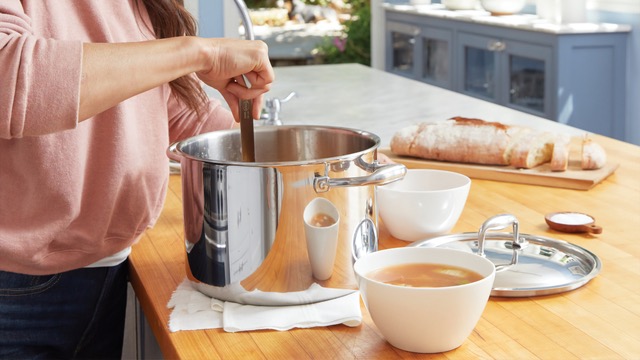It’s all the rage—a nutritional bonanza promising everything from clearer skin, more lustrous hair, fat loss and fewer colds. It’s impossible to walk into a grocery store—healthy or not—without finding bone broth on the shelves. Have you seen the prices for a container of bone broth? It can set you back $12 per quart, where regular stock is about $3 per quart. Why the delta? For one, broth requires 12-24 hours to produce vs. 2-4 hours for regular stock.
The Benefits
Bone broth has become both a drink and a base for healthy dishes. It’s richer in color and flavor and believed to be healthier than stock due to a higher nutrient content. Animal bones and their connective tissues contain vitamins and minerals such as calcium, magnesium, iron, vitamins A and K. It also contains a mega-dose of collagen and amino acids, the building blocks of protein. Simmering bones over a long period of time is believed to release these minerals.
Studies have shown the physical benefits of bone broth may:
• Protect joints and prevent osteoarthritis
• Reduce inflammation in the digestive tract
• Aid and improve sleep
• Support weight loss
• Prevent dehydration
Make Your Own Broth
You can skip the high priced broths on the market and make your own broth for a fraction of the price. Follow these tips to get the most out of the process. You can use any type of animal bones; I find chicken bones and broth to be the easiest to work with. I roast my own chicken for dinner about once a week. If I don’t have the time to use the bones right away I freeze them and double up the next week for bone broth.
• Take the chicken carcass and separate all the bone segments. Using a large sharp knife cut the cartilage off at the joints to expose the bones. Continue to chop the bones in half to expose the internal bone marrow.
• Using a large soup pot cover the bones with water to the top of the pot (about 1 gallon).
• Add peppercorns and 1 ounce of vinegar. Any type will do.
• Boil the liquid, then, partially cover reducing to a simmer for 12-24 hours. Add water when needed.
• Strain and use immediately or pour into smaller containers for storage.
• You can vary the recipe and up the nutrient content by adding aromatic vegetables and herbs to the pot.
Enjoy!
Back To Blog

